#dm tools
Text
Curated Spotify playlists to liven up your D&D sessions!
I have always loved playing D&D with background music that fits the location, mood, or type of combat, so I created several playlists on Spotify. This project is something I've been working on since December 2019, and something I want to share with you all! You can find the list below.
If you have suggestions for songs/tracks to include, or if you want a specific playlist that is not in this list yet, please let me know! And most of all, have fun!
Locations
Astral Plane
Ball/Masquerade
Bazaar
Castle/Court
City
Desert
Dungeon
Festival
Forest
Jungle
Monastery
Mountains
Schools of the Arcane
Ship
Tavern
Temple
Town/Village
Underwater
Moods
Creepy/Eerie
Dramatic
Enchanted
Energetic/Adventurous
Heroic
Grand
Intrigue
Menacing
Mysterious
Night
Peaceful
Sad/Mourning
Silly
Tender/Emotional
Combat
Small Battle
Big Battle
Boss Battle
Tavern Brawl
Chase
Themes/settings
Ancient Greece
Bard songs
Patrons/Visions
Visions/Dreams
#dnd#dnd 5e#ttrpg#music#spotify#playlist#writing#writing inspiration#spotify playlist#d&d#dungeons and dragons#worldbuilding#dm tools#resources#reference
1K notes
·
View notes
Text
Alright, guess it’s time to address the apocalyptic legal elephant in the room:
For those who might not know, WotC plans were leaked to “update” the OGL in what is basically a scorched earth policy with regards to 3rd party material/creators in the hopes of cutting out the competition and forcing people to use their new products.
As someone who lived through the 4th edition/pathfinder schism, the situation is laughably similar: D&D is flourishing more than it ever has (thanks primarily to the OGL) but the execs at Hasbro want more of the money spent on the hobby to wind up in their pockets. Oblivious to the fact that the opensource nature of the game is what draws people to it, they task the design team with creating a proprietary virtual tabletop through which they can sell d&d content without having to worry about books or pdfs being pirated. This rightfully outrages the fandom and burns every scrap of good will they had towards WotC, resulting in a dead edition that’s maligned years afterword as folks hop to the newer, easier game system.
The thing that’s different this time is that the d&d playerbase has grown exponentially since the days of the first OGL, with 5th edition being the easiest version of the game to run/pick up and so many resources online, there’s almost no barrier to entry besides finding a stable/accommodating group. Hell, with the explosive popularity of liveplay series you don’t even need to be actively playing in order to be in the fandom. All of these people are networked together in a fandom hivemind spread across twitter/reddit/youtube and WotC just made an enemy of every single one of them with its shameless and destructive cashgrab. No streamer or 3rd party publisher wants to give Hasbro 25% of their revenue, to say nothing of having their project “cancelled” if WotC sees it as a threat to any of their current projects ( see the huge number of spelljammer materials published after the company dropped the ball).
It took about two years after the announcement of 4th edition for Paizo to come out with pathfinder, and I have no doubt the OGL leak kickstarted every major 3rd party publisher brainstorming some legally distinct version of the 5e ruleset. In the coming months I expect to see a number of these surrogate systems floating around the internet in much the same way that the onednd playtest content, but spurred on with the added “fuck you Hasbro” energy. After that, it’s only a matter of time till one of the big streamers picks up one of these systems and popularizes it, not wanting to pay the 25%tithe to WotC. Personally my money’s on Critical Role: they were one of the major factors in popularizing 5th edition and they’ve got the fandom pull to legitimize any claimant to the throne.
To step away from playing oracle for a bit, I’d like to finish up this post by dunking on WotC:
*ahem*
HOW FUCKING DUMB TO YOU HAVE TO BE TO TURN YOUR ENTIRE CUSTOMER BASE AGAINST YOU IN ONE NIGHT? This is some new coke/Reynolds pamphlet/invading Russia in winter levels of shooting yourself in the foot. Wizards was on shaky ground to begin with given that they’re coming off a series of notably disappointing products AND trying to launch a new edition/virtual tabletop/battlepass system, but to follow that up with a retroactive rules change that lets them outright steal from or shut down creators? It’s laughable. Maybe, MAYBE they could have made this work if they were knocking it out of the park with new releases every year and cultivating a base of diehard WotC loyalists, but the fact of the matter is that aside from the brand name, the hobby has largely passed them by. Everything that Wizards does, from player options to settings to monsters to rules modules, someone else does better because they’re willing to take risks and put in the effort. Aside from the elegant simplicity of 5e’s base system, I can count maybe two pieces of actual game design (piety from Theros, ship combat from Saltmash) that I consider usable at my table, which is SAYING SOMETHING considering we’re nearing the end of the game’s ten year golden age.
I know we’ll weather this storm, we always have, and regardless of what happens I still know my friends and I will enjoy gathering around the table and slinging dice even though we might not be playing “dungeons and dragons” in a couple years time. I’ll keep my eye on the horizon, and let you know where I find safe harbour.
#dnd#dungeons and dragons#d&d#5e#dm advice#dm tip#dm tips#dm tools#writing advice#one d&d#dapper digresses#ogl#ogl 1.1#hasbro#critical role#open d&d#opend&d
2K notes
·
View notes
Text
Hey all, This is my first Tumblr post ever! I'm pretty new here, but I'm hoping to share some DM techniques, tools and tips and to make some new friends as well! Feel free to send a chat request (an ask[?]) if you're interested!
With that aside, on with the post!
Better and More Meaningful Random Encounters!
Random encounters are a staple of DnD, they are expected to be there during exploration as a way to make the world feel alive, to have it have an aura of adventure and danger, to eat up party resources and put pressure on the PCs to make interesting and important choices, and also as a way for a DM to reasonably 'stall' the party with a quick and easy situation.
Usually, it ends up something like this:
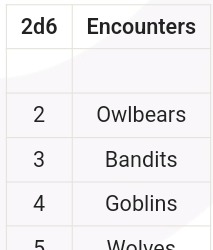
There's just one problem with most random encounter tables though, it's so easy for them to be GOSHDARN BORING! Especially for a newer DM.
Making them interesting becomes gambled improv on the DM's part if they're not used to it, and it's hard to keep track of the important factors that need to be kept in mind
Luckily, I ended up finding a great source for random encounters from 'Dungeon Masterpiece' on YouTube, and I integrated it into my own DMing. I figured that I'd share it here for any that want to work it into their own sessions as well!
After adjustment, a single table can account for multiple entire sessions of in-depth worldbuilding and fun without getting dull!
Sources:
Source 1 (Creating interesting Random Encounter Tables):
youtube
Source 2 (Making Random Encounters reflect your Worldbuilding):
youtube
There's 4 major methods we can use to improve the Random Encounter table
1. Make the table a straight 1dx roll.
2. Adding 'depth'.
3. Adding meaningful encounters.
4. Prerolling and/or Multirolling.
You can also check out the "Where to Start?" section for some direction to make getting it down and prepped all easy peasy!
1. Straight Roll:
Its enticing to go for 2d6 or the such in order to add non-linearity to the rolls, but these sorts of adjustments only end up making one or two encounters extremely likely and leave all others in the dust, it often ends up defeating it's own purpose of interesting randomness.
In the previous example, it was extremely likely to only get Wolves, Barbarians, Orcs, or Spiders, from a table of 12! A straight roll would serve us much better. The rare rolls are already rare enough as is!
Simply enough, adjusting the original example by replacing the 2d6 with 1d12, it'd become something more like this:
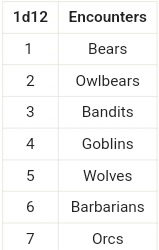
#2. Adding Depth:
We can add more columns in the encounter tables. These columns will represent different aspects about the encounters that we can roll on separately!
Usually it can be difficult as a DM to naturally come up with motives for the encounters, showcase the worldbuilding and have it all come together.
This setup can give you a solid guideline on how the creatures/people think (if any), and also sets up the overall area so that you get an idea of what events tend to occur there as a result of its occupants.
We want to add 3 more columns to the tables to convey different aspects of the encounter. Fill in these new columns corresponding to the expectations of each encounter.
We'll roll each of these and combine them, then we'll interpret them to make a robust, in-depth random encounter with truly unexpected results!
I recommend rolling alot of complete encounters at once and interpreting the context to the vast general area the party is travelling in.
i. Behaviour: How the creatures act. Are they friendly, scared, aggressive, curious, mischievous?
ii. Complication: Something behind the scenes in the encounter. Do they have sick young? Broken equipment? Are they starving?
iii. Significant Impact: This is a tick box, and will only be present under ONE of the rows. It will be rolled like the other columns, but ONLY once. It signifies which encounter is the Significant Encounter
The Significant Encounter will have its encounter's presence prominent amongst all the other random encounters in the area. There could be burn marks and carcasses from a rampant dragon, or a goblin raid leaving tracks moving through the area. Which is the most impactful of the different encounters?
Adding this to our previous example would expand it to:

Rolling this would give us things like:
Significant encounter: Owlbears

Note that the significant impact shows that the Owlbears are a massive problem in the area. Perhaps the Owlbears are agitated for an unknown reason, and are unnecessarily aggressive.
The significance of Owlbears gives us context to the second one as well! Perhaps the hunters raided an Owlbear den, and adopted an Owlbear cub from there as well.
There could be uneaten carcasses, ravaged trees, less wildlife, etc around these parts.
Note how much sheer CONTEXT these columns add to our encounters. It's invaluable!
3. Adding Meaningful Encounters
Usually random encounters tend to be rather mundane and very one-note.
There's usually some general wildlife and monsters, different disparate factions without any rhyme or reason, and maybe a general non-combat encounter or two, but these don't really tell us about the area or its surroundings at all by themselves.
Instead, we can add in wildlife and monster encounters specific to the biome, non-combat encounters, and encounters of nearby factions and/or settlements to the table, and we can even add environmental encounters in there as well.
Note that we're not tied down to 12 encounters, and can expand it ad infinitum according to our need of diversity in our encounters.
Just add in specification and connection, and suddenly the dominos all fall into place.
Lastly, we'll also be adding in 'DOUBLE TIME' which will let us roll on everything twice, and make it so it's a double encounter!
Thus, the table can instead be adjusted to:
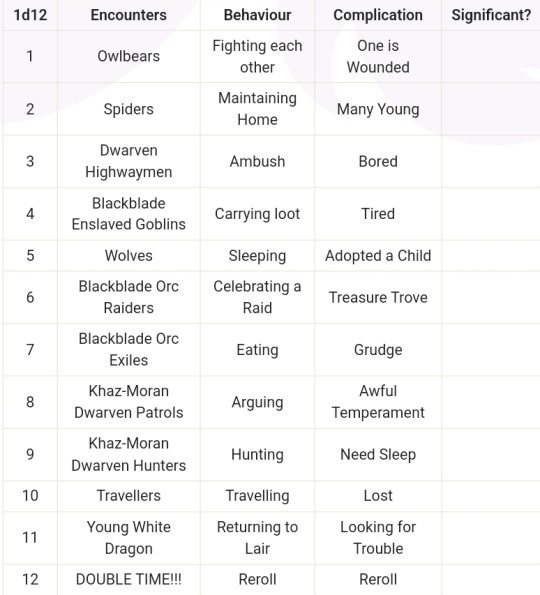
Note how each and everything has its relation in one way or another, but through the sheer variance, they remain truly random and novel.
4. Prerolling and/or Multirolling
Lastly and this is just something that I do, but that I found gamechanging. Be sure to pre-roll 5-7 encounters for each session, for the general area the players are going to be headed in.
Note that you don't need to really prep anything at all, just interpret all of them on a surface level as a buffer.
Also note that you don't need to use all of them if they're not needed. The foreshadowing and signs are worldbuilding and having secrets that the players don't unravel is just as useful as the ones that they do, perhaps even moreso. It adds depth and detail beyond the scope of what the party will encounter
It simply let's you get an idea of the connections between encounters, allows for foreshadowing, and acts as a deterrent to getting caught off guard.
Even if you roll mid-session, I recommend calling for a 5 minute break, rolling 5-7 encounters at the same time and interpreting them and their connections before resuming the session.
It WILL make a difference, trust me
Where to start?
It can be difficult getting inspiration or direction to get started in creating these random encounters, and sometimes you don't want to go through the hassle of thinking them up from nothing
For some great conceptual headstarts and examples for these tables, you can check out 'Worlds Without Number' and it's:
- Page 205 (Great general templates for encounters differentiated by broad creature types such as Beasts and Monsters, Sapient Monsters, and Humans)
- Pages 206-219 (For inspired locations to occasionally run rare encounters or groups of encounters in. This works best with flexible/discovered worldbuilding given the significance of some of these, and you also want to add these in sparingly to keep them significant)
- Pages 246-247 (These pages have great templates for the kinds of encounters and situation to be included in the tables, and it can be expanded vastly, and certain options can be selectively and repeatedly chosen to meet our needs. Mood works well as a complication.)
There might be other pages that are useful as well for these sorts of random encounters in the wilderness that I haven't come across yet. If so, give them a shout out and I'll be sure to add them in. It's worth checking it out in its entirety for some great tips!
Conclusion
Again, credit goes to Dungeon Masterpiece and Worlds Without Number for excellent adjustments. This has been quite long, but I hope you stuck around till the end.
Many a session have been made easy but complex ever since this was introduced and I hope that this helps you out as much as it helped me in my prep and improv!
Feel free to give any advice in formatting on Tumblr, or any feedback on the post itself. It really means a lot to me, thanks!
#dm tools#dungeons and dragons tips#dungeon master tips#dm advice#dm tips#ttrpg#dnd#Youtube#dnd resources#gm tips
58 notes
·
View notes
Text
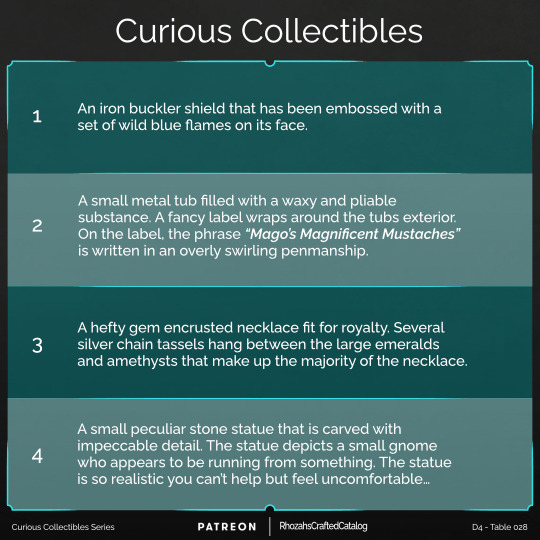
More weekend means more Curious Collectibles tables of course!
A unique shield with hidden properties?
Need a new look or want to impress at the next festival?
What is such an elaborate necklace doing laying in the street?
Do those statues have pores... and tears?
What option would you choose?
This table is available, free for you to use in your home DnD / Pathfinder / Tales of the Valiant / Daggerheart / TTRPG games, to help generate some more descriptive loot and treasure options perfect for a new quest-hook or a truly epic reward.
If you love ttrpg stuff like these and want access to more options for your Dungeons and Dragons or Pathfinder game as well as a hoard of printable paper minis, terrain and monsters to help fill your table, check out my Patreon page! I create affordable paper minis, VTT Tokens and more, with a release every week! You can follow for free so you never miss a drop or join as a member to get access to all the extra Patreon exclusive goodies.
#dnd#d&d 5e#d&d#dnd resources#dungeons and dragons#dungeon master#dnd campaign#dnd5e#d4 table#critical role#daggerheart#random tables#Curious Collectibles Series#dnd loot table#worldbuilding#ttrpg#ttrpg community#dm tools#dnd inspiration#roll tables#dnd 5th edition#pathfinder#pf2e#pathfinder 2e#rpg#dice#game master#ttrpg resources#dnd homebrew
18 notes
·
View notes
Text
So my campaign has come to a new arc, which has me doing something I’m not super well versed in and have attempted only semi successfully in the past.
I’m writing mystery and ‘political’ intrigue.
TL;DR I would love to have some advice and anecdotes for what has worked for you, yes you, as a player or DM.
My players have arrived in the (primarily) Elven city of Avalis in the nation of Goram’Andiel. The city is grown directly into the structure of some massive mangrove trees- all connected back to a central mother tree in the heart of the city. Buildings have been sung and grafted into the living wood and wooden walkways built between boughs and branches. Gondolas traverse the waters below where stone buildings have been integrated here and there among the roots and docks on stilts protrude into the River Arterius that winds lazily through the cities heart and also along tram lines that weave throughout the upper reaches. The city- while primarily home to various elven peoples is also home to half elves, humans, kenku, aarakockra, Owlin, Hadozee, lizardfolk, and even river dwelling Triton.
The group has come for multiple reasons: to meet with allies from their home country in secret in order to exoerate themselves in the killing of one of their enemies who was a powerful political leader in their own capital. To learn of a powerful ancient relic of the Sundering and what came before. To seek the location of a lost burial site. To learn more about the foreign souls they are hosting in their bodies, and what the intent of these souls is. Much of their search involves a place called the Woven Knot Archive and it’s High Curator, Amber Enathard, a powerful Wizard and Cleric who also serves as one of the cities three high ministers. They are racing against three cults called The Grasping, The Hollow, and the Starved- three sects of folllowers surrounding what they believe is the reincarnation of the moon goddess who will cleanse the world in fire and chaos and end the events that began in the sundering.
Shortly after arriving in the city the group wakes up to the Archive burning. The archive is also home to the national library and the natural history museum. And it’s these structures that were burning. In the chaos the group made their way to help, only to learn their contact, Amber, was inside. They rushed in to save her, stumbled upon the burned remains of a device, and found a fire elemental battering against the wards of High Curator Enathard. The group handily defeated the fire elementals, allowing the guard outside to effectively stop the fire and discovered that the person responsible for the firebomb and elemental slipped into the crowd in a guard uniform.
The group was asked to help with the investigation, and to speak to the cities High Ministers about what they saw and heard in the Archive as they fought inside it and rescued people. And now they’ve discovered more hooks. The scorched device they found was the baseplate and fissile material for some kind of arcane bomb- one that could open a large portal very near the center of the elemental plane of fire. That baseplate had a symbol on it from a group known as the Order of the Megalos Psychi, a sect of artificers and Alchemists from the same town a PC’s monastery was. Additionally the materials used to create the device were not something naturally occurring on this plane. Some other mysterious things happened and clues presented themselves for the group to ponder. Who was the person in guard uniform the group saw escape into the crowd rather than try to help during the fire? Why has the woman they rescued and saved from harm still in a coma like state? Why was the archive attacked, and who was the attack meant for? The group? The high curator, or something else? What does the O.M.P have to do with it? Where is the cultist leader that allies of the group tracked to this city and what is she planning? With many questions and not many leads at the moment the group has found themselves thrust into an investigation they aren’t allowed to move on from and one they don’t have clearance to investigate themselves (legally that is).
I’ve done a lot of work with the various NPC’s this arc, and how all the pieces of things tie together. some stuff has already happened that’s changed how things will play out and rearranging things to match up is pretty cool and I’m having a good time, but because I’ve put in so much work already plotting and thinking about this intrigue I feel ready for what comes next.
Still, I am new at this. And I’m curious how others handle finding clues, political machinations and getting the PC’s willing to manuever and hunt for clues both socially and sneakily. Let me know!
#dnd#my writing#it speaks#homebrew dnd#dnd homebrew#eldritch soul campaign#intrigue#dnd mysteries#dnd intrigue#Dm tips#Dm advice#dm tools#awhellstothejoe#tell me about your fantasy games
109 notes
·
View notes
Text
hoho! art thou making battle maps? fantasy world cartography, perchance?
forgotten adventures has +120 000 high resolution assets [11 GB] available to download for free on their website!
frequent user of dungeon draft? they have +30 000 free objects available on their starter pack as well!
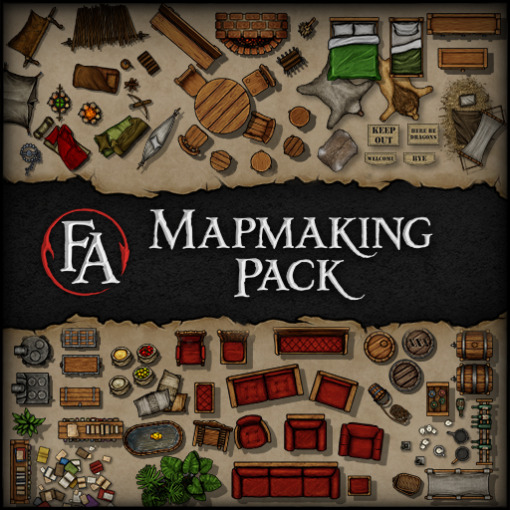
#websites#dnd#dm tools#tech tips#wizardblr#dnd maps#dnd resources#ttrpg#ttrpg community#pathfinder#worldbuilding#gm advice
8 notes
·
View notes
Text
I am in all things,
Each shade and hue.
Invisible,
Yet visible too.
You only see the surface
When I see you.
A riddle. Probably thought I'd put the answer down here, didn't you. But not yet. If you have a guess stick it in the tags.
24 notes
·
View notes
Text
Welcome to an inner look at the machinations of my world building and some tips for dms
Hags
They are fucking fantastic
Easy to tease with disappearing children or a strange (polymorphed) kid or hag
If the party kill one, other members of the dead ones coven might try to avenge their brethren and hunt the party
A good intro to enemy spellcasters and craftier tactics
Show players the value of potions
Now this is assuming that the hags are enemies. They make fantastic friendly npcs whether as an eccentric shopkeeper or a quirky patron. They also have the fantastic utility of a hag eye. It’s a old withered eye they can see out of no matter where it is. This opens the door for espionage or finding who is watching you
In my world
I have 3 npc hags in the city where the pcs are. Kaithretoo the recluse, Molingret the onlooker, and Zaquatious the emboldened. They all work one way or another for a criminal organization called the crossroads
Molly runs store that attracts would be recruits for the crossroads. She sells various nefarious tools like poison and lock picks and keeps tabs on the buyers to see if they are worth it to recruit.
Kait is known as the queen of the underground and directs the crossroads members assignments when she’s not transforming political enemies into spiders
Zaq has managed to infiltrate the upper echelon of nobles after being recognized for her arcane prowess and becoming the reining leader of the crescent spire (an arcane research facility) when her superior went missing.
The amount of plot threads or missions just these three could lead to are incredible. Feel free to take them for your own world or just use them for inspiration
45 notes
·
View notes
Text
Truths & Rumors
When starting a new campaign or wanting to create a brand new setting try this with your group:
Before starting your first session go around the table starting with yourself and ask each player, "What is one true thing that is known by most in this world?"
These are the 'Truths' of this brand new campaign/world. These are the things that are just known about the setting/world.
Next, starting with yourself again, go around the the table and ask each player, "What is one rumor that is known by most in this world?"
These are the 'Rumors' of this brand new campaign/world. These are the rumors that pass around the world by word of mouth. Recent rumors or legends of old.
With these rumors they can be rolled on to see if the rumors are true or false. Or maybe some rumors just stay rumors. But some rumors can cause trouble when rumors are to be believed true by others.
#d&d#dungeons and dragons#dm tips#dm tools#ttrpg#ttrpg design#5e#dnd 5e#dungeon master#game master#dnd#d&d campaign
68 notes
·
View notes
Photo

Adventure Archive TTRPG assets for May!
This month's TTRPG assets are up in the Adventure Archive, a collection of ✨377📷 items! Patrons & ko-fi members $5 and up get access to the asset archive for their games & can make monthly requests for ones they'd like added!
https://patreon.com/TriaElf9
https://ko-fi.com/triaelf9
21 notes
·
View notes
Text
A Simple Fantasy Biome Generator Zine
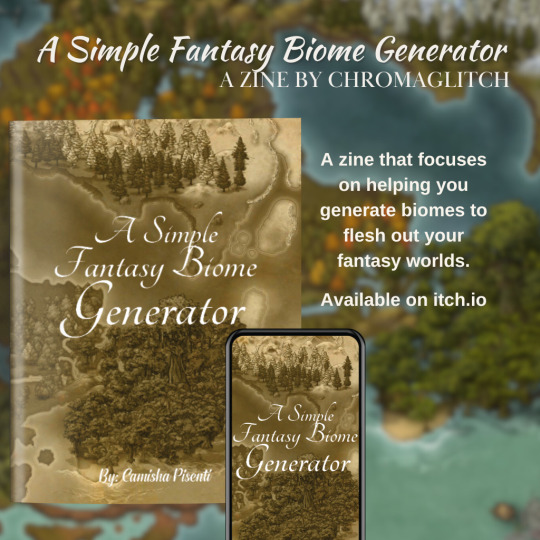

A Simple Fantasy Biome Generator focuses on helping you generate biomes to flesh out your worlds. You can use this generator for creative writing, TTRPG homebrew settings, and even art inspiration. Throughout the zine, you will find several tables with biomes and flora and fauna inspiration. I will also include some examples I created using the generator and digital programs.
Included in the PDF Download
1 Biome Generator table (20 examples)
1 Fauna Generator table (20 examples)
1 Flora Generator table (20 examples)
Map examples
Needed materials: pen, paper, dice (a D20)
Size: Digital, A5, 16 pages (including front & back cover)
If this generator helped you or if you have any feedback, please let me know!
#ttrpg resources#ttrpg stuff#ttrpgs#creative writing#a simple fantasy generator#ttrpg zine#dm tools#dnd#dungeons & dragons#pathfinder 2e#zines
8 notes
·
View notes
Photo
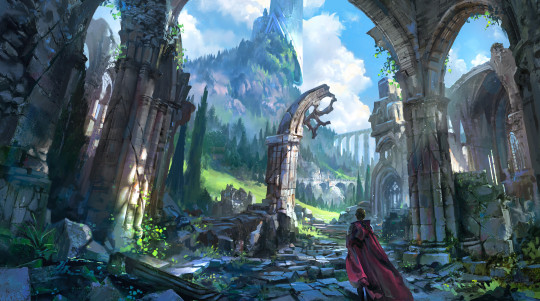
Drafting the Adventure: Dungeons Without Walls
I love the idea of dungeons, but there was a significant portion of my life as a DM where they didn’t feature in my games. While Pathfinder and 5e provided a great framework for character building and tactical skirmishes that I could build story on top of, neither was really great when it came time to detour into a dungeon. My players tended to get confused when we headed out to plunder the local ruin or cave system, spending a lot more time figuring out where they were and what they should be doing than actually doing anything.
The problem as it turned out was limited information. I had a picture of the dungeon in my head/notes but I couldn’t telepathically infer that to the party, and the back and forth questions where they tried to orient themselves within my mental labyrinth ate up a lot of session time prevented us from attaining that snappy pace that every table needs to keep the players invested.
Recently though I had an epiphany about overhauling exploration in d&d, and wrote up a whole post detailing how you could build and run wilderness adventures the same way you could a heist or a murder mystery. Because I was already writing a series about dungeon design it didn’t take long for me to realize that this exploration overhaul was 100% applicable, and could solve a lot of the delay and confusion my players usually faced on their next trip underground. Spoilers: it worked amazingly.
The key to this overhaul was giving my players enough information to see the dungeon as a sort of abstract checklist, and then giving them the power to investigate and check things off that list in whatever order they wished, when they enter a new level of the dungeon they get a new checklist to fill out which still keeps that sense of exploration. Folk love checking things off lists, and I as a dungeonmaster love it when players engage with the content I’ve spent so much energy creating even if it’s only poking their head in the door to realize they want to run away as fast as possible. Likewise, designing the dungeon this way let me tackle much larger concepts without having to sweat the details of filling up every little room as I would have to in map-centric design.
To summarize my exploration mechanic as It applies to dungeons:
During Design: After you’ve got the dungeons’ major concept, you divide it into unique “zones” (essentially what might be levels in a regular dungeon) with an interconnected theme, mechanic, or threat.
Each zone has a number of points of interest, which can be anything from trails to follow, odd sights they might investigate, to full complexes of rooms that you’ve mapped out. You don’t need to map out the points of interest otherwise, they sort of float abstractly within the zone
When players enter a zone, they become aware of its name and general descriptor, as well as how many total points of interest are in that zone. They also become aware of some points of interest immediately to serve as landmarks and give them a direction for their exploration, but most remain undiscovered until they venture off the path and start checking out their surroundings. Hidden among these points of interest are the doors that lead to zones deeper within the dungeon, encouraging the party to explore in order to progress.
During Play: When the players enter the dungeon, one player is appointed as the surveyor, who’s job it is to keep track of the zones, fill out that checklist, and check things off when the DM tells them that they’ve fully explored a point of interest.
Rather than needing to be aware of the exact room layout, the party just need to know what zone they’re in and what options are available to them, Because this information is delivered in the form of a checklist with empty spaces, the party know exactly how much of the dungeon they’ve explored, what’s left to explore, and when they’ve cleared out an area.
Lets take the image above as inspiration. Say the party is trying to make it up to the tower, you can easily see a progression of zones and maybe imagine a few to go alongside them:
Ruins & Foothills: The first area, filled with the remnants of an ancient civilization. Picked over by looters and now a home to all sorts of wildlife,
Mountainside: The obvious next goal, but locked off behind a challenging climb, Filled with hazards that threaten to knock the party back down to the foothills if they’re not careful
Caverns: Secret area accessible only if the party explore a cave on the mountainside, or make a beeline towards the old aqueduct landmark in the foothills, realizing it might be easier than the climb.
Spire Foundations: The door connecting to the foothills is guarded by a complex puzzle and arcane ward, but the party might be able to sneak in through the caves where erosion has caused a breakthrough into the cellars.
Spire Peak: High among the clouds, the party’s prize is somewhere here. Access to the upper sections of the tower are guarded by a territorial sphinx under arcane compulsion, though the party might just be able to skip that fight if they figure out the riddle to make the portal mirrors work in the foundations.
Trying to design all this by pencilling it in on a gridmap would take weeks, to say nothing of the headache it’d cause you trying to make things fit together and fill up empty space with content. Designing it first as a sequence of zones and then filling those out with interesting fights, puzzles, and encounters is the work of an afternoon or two. Likewise, its easy on your players: five zones with six to ten points of interest is far easier to tackle when you can make a checklist and see how much progress you’ve made, despite the fact that the area they’re exploring is quite vast.
I hope you find this as useful as I have, and if you need a more concrete example of how it might work, don’t worry, I’ll have one of those for you in the coming days.
#dungeon design#dnd#dungeons and dragons#d&d#5e#dm advice#dm tip#dm tips#dm tools#writing advice#pathfinder#ttrpg#homebrew#5e homebrew#homebrew mechanic#exploration
609 notes
·
View notes
Text

#menu#takeout#takeout menu#food#fantasy food#rpg#rpg food#dnd#d&d#d&d food#dnd food#parody#parody?#rpg supplement#dm tool#dm tools#handout#leaflet#osr#classic
18 notes
·
View notes
Text

Another weekend is rolling in and what better to have than another roll on a new Curious Collectibles table of course!
Who was trying to hide the name of this old journal and why?
What could this odd contraption be used for?
Could this signet be from one of the fallen knights?
Is this a scam or a real potion? Do you dare open it to find out?
What option would you choose?
This table is available, free for you to use in your home DnD / Pathfinder / Tales of the Valiant / Daggerheart / TTRPG games, to help generate some more descriptive loot and treasure options perfect for a new quest-hook or a truly epic reward.
If you love ttrpg stuff like these and want access to more options for your Dungeons and Dragons or Pathfinder game as well as a hoard of printable paper minis, terrain and monsters to help fill your table, check out my Patreon page! I create affordable paper minis, VTT Tokens and more, with a release every week! You can follow for free so you never miss a drop or join as a member to get access to all the extra Patreon exclusive goodies.
#dnd#d&d 5e#d&d#dnd resources#dungeons and dragons#dungeon master#dnd campaign#dnd5e#d4 table#critical role#daggerheart#random tables#Curious Collectibles Series#dnd loot table#worldbuilding#ttrpg#ttrpg community#dm tools#dnd inspiration#roll tables#dnd 5th edition#pathfinder#pf2e#pathfinder 2e#rpg#dice#game master#ttrpg resources#dnd homebrew
7 notes
·
View notes
Text

A WinterVeil gift from his children - @melekdyneer
5 notes
·
View notes
Text




We met our funding goal already! Grab yourself a set!
@havocshoard on IG
#beautiful#rpg dice#dice goblin#dice maker#dice addiction#my dice#resin dice#d&d dice#handmade dice#polyhedral dice#dice#dungeons and dragons dice#dndart#dnd#dnd dice#dm tools#critical role
18 notes
·
View notes